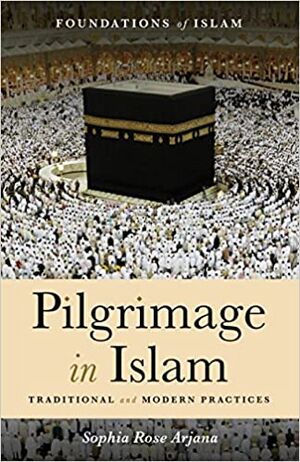Pilgrimage in Islam
The book Pilgrimage in Islam: Traditional and Modern Practices (The Foundations of Islam) is a solid contribution to the field of pilgrimage and Islamic studies that provides provocative case studies and theorizations on pilgrimages, spatiality, and ritual performances in Religious Studies.
 | |
| Author | Sophia Rose Arjana |
|---|---|
| Language | English |
| Genre | Islamic studies |
| Published | 288 |
| Publisher | Oneworld Academic |
| Pages | 309 |
About the author[edit | edit source]
Dr. Sophia Rose Arjana is Associate Professor of Religious Studies in the Department of Philosophy and Religion at Western Kentucky University. She has published articles, book chapters, and books on several subjects in the study of Islam, including pilgrimage, Islamophobia, popular culture, and feminism. Her first book, Muslims in the Western Imagination (Oxford University Press), examines the history of anti-Muslim rhetoric in Europe and North America. It received accolades from fellow scholars and is being published in an Arabic edition in 2018. Her second book, Pilgrimage in Islam: Traditional and Modern Practices (Oneworld Academic), is a comprehensive study of pilgrimage, ritual, sacred space, and technology in Islam. In November of 2017, Dr. Arjana's third book was published, a study of Muslim female superheroes, such as Ms. Marvel, Qahera, Raat, and Burka Avenger. This work, titled Veiled Superheroes: Islam, Feminism, and Popular Culture, is published by Lexington Books. Her latest book focuses on the commodification of mysticism in North America and Europe, new age religion and spirituality, and cultural colonialism. Titled Selling Rumi, Buying Buddha: Mysticism in the Modern World, it will be published by Oneworld in August 2020.
Dr. Arjana received a bachelor’s degree from Hawaii Pacific University, and master's degree from Columbia University in New York. After a second M.A., in theological studies, from Candler School of Theology at Emory University, she received her Ph.D. degree from the University of Denver.
About the book[edit | edit source]
This book published in Oneworld Academic (July 3, 2017), has 288 pages and best sellers rank of 784,391 in Books.
Dr. Arjana in her book provides a rigorous theoretical discussion of pilgrimage, ritual practice and the nature of sacred space in Islam, both historically and in the present day.
Abstract of chapters[edit | edit source]
- Chapter 1, Reconsidering Islamic Pilgrimage: Theoretical and Sectarian Debates
In the first chapter, Arjana presents the discussion of Islamic pilgrimage and its examination in the field of religious studies through documenting spaces and sites, geographies, and imaginations. this is visualized through architectural designs and structures related to ziyārat, like those named qubba, mazār (shrine), qabr (tomb), darih (cenotaph), mashhad (site of martyrdom), and maqām (place of a holy person).
- Chapter 2, Nascent Pilgrimage Centers: Jerusalem, Mecca, and Medina
The author continues the theme of visiting sacred pilgrimage sites like “nascent Jerusalem”, Mecca, and Medina and talks about the importance placed by Muslims on Jerusalem in Islam, hajj, ‘umrah, and related traditions in Medina.
- Chapter 3, Shi‘i Pilgrimage: The Prophet's Household
The third chapter explains the pilgrimage traditions associated with Shi‘i Muslims, including Zaydis, Isma‘ilis, Twelvers, and two groups that are associated with Shi‘ism – the ‘Alawis and Alevis. The writer believes that Such Islamic pilgrimages are marked by inclusiveness and cohabitation.
- Chapter 4, Sufi and Shared Pilgrimages: Contestations of Identity
This chapter focuses on Sufi pilgrimages, traditions that exist in the world and are practiced by Sunnis, Shi‘i, and other Muslim sects. It looks at some of the pilgrimages that are shared among Muslims and other groups, such as Christians, Hindus, and Jews. The writer in this chapter cites numerous sites that offer fluid spaces for the expression of different identities, the practice of distinct rituals, and cohabitation of different religious communities through the idea of “shared pilgrimage”.
- Chapter 5, Modern Muslim Pilgrims: Tourism, Space, and Technology
The fifth and final chapter focuses on the topics of materiality and modernity of Islamic pilgrimage. It also examines the topics of technology and cyber-pilgrimage, offering a reflection on the ways in which modernity is changing Islamic pilgrimage and offering new ways of experiencing sacred sites. The writer believes that this modernity forms a part of Islamic pilgrimage in our times, amplifying how pilgrimage itself is a wide range of “active, ongoing, dynamic rituals, traditions and performances that involve material religions and imaginative formations and spaces.